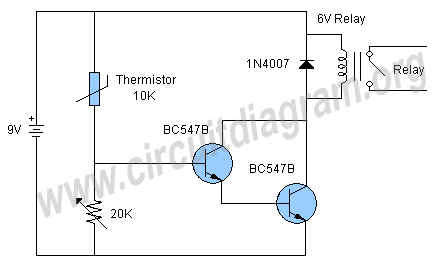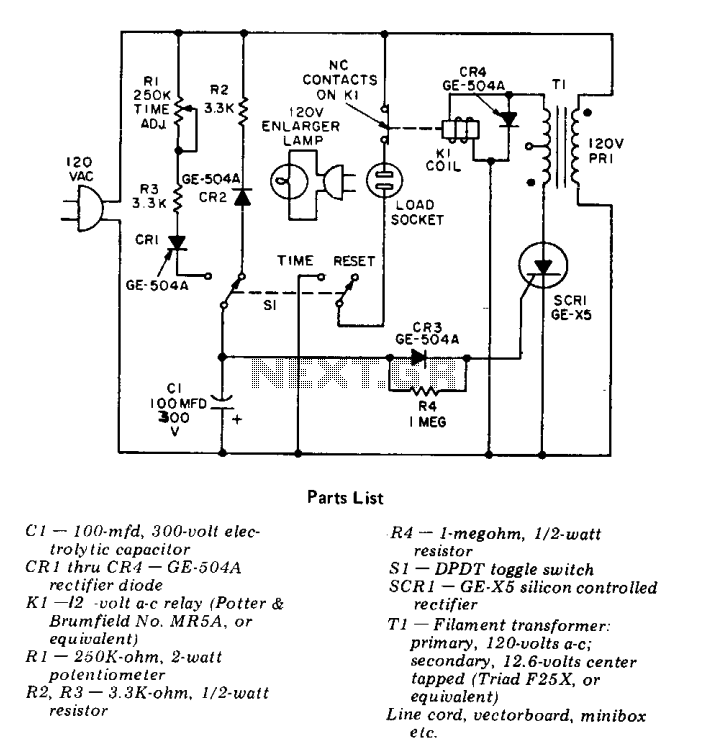
temperature sensor relay switch circuit

The circuit operates based on a desired temperature setting. It can be utilized for various applications, such as turning on a fan at a specified temperature or activating an emergency temperature alarm. The power supply for the circuit can be a 9-volt battery, an adapter, or a transformer. Two BC547B transistors are configured as a Darlington pair to enhance sensitivity and gain. A 20K variable resistor is incorporated to adjust the temperature level at which the relay switch is activated. It is advisable to position the thermistor at a distance from other components to prevent heat interference.
The circuit is designed to monitor and respond to temperature changes, providing versatility in applications such as cooling systems and safety alarms. The use of the BC547B transistors in a Darlington configuration allows for greater amplification of the input signal, making the circuit more responsive to small temperature variations.
The thermistor serves as the primary temperature sensing element. It is critical to select a thermistor with a suitable resistance-temperature characteristic to ensure accurate readings. The placement of the thermistor is essential; positioning it away from heat-generating components minimizes the risk of false readings caused by ambient heat.
The 20K variable resistor acts as a calibration tool, allowing users to set the threshold temperature at which the relay activates. This feature provides flexibility, enabling the circuit to be tailored for specific operational requirements. The relay, once activated, can control larger loads, such as a fan or alarm system, providing an effective means of temperature regulation and alerting.
Powering the circuit through a 9-volt battery, adapter, or transformer ensures that it can be used in various settings, from portable applications to fixed installations. The choice of power supply will depend on the intended use and the availability of power sources.
In summary, this temperature-controlled circuit is a robust solution for managing thermal conditions in various environments, leveraging the sensitivity of a Darlington pair configuration and the adjustability of a variable resistor to achieve precise control. Proper component placement and selection are critical for optimal performance and reliability.on the desired temperature. The circuit can be used for many purposes for example switch on the fan on the desired temperature or activate emergency temperature alarm etc. The circuit can be powered by a 9 volt battery, adaptor or transformer. The two BC547B transistors are connected as a Darlington pair to increase the sensitivity or gain of the
circuit. A 20K variable resistor is used to adjust the desired level of heat on which you want to activate the relay switch. Try to fit the thermistor a little bit away from the other components so it will not get their heat. 🔗 External reference
The circuit is designed to monitor and respond to temperature changes, providing versatility in applications such as cooling systems and safety alarms. The use of the BC547B transistors in a Darlington configuration allows for greater amplification of the input signal, making the circuit more responsive to small temperature variations.
The thermistor serves as the primary temperature sensing element. It is critical to select a thermistor with a suitable resistance-temperature characteristic to ensure accurate readings. The placement of the thermistor is essential; positioning it away from heat-generating components minimizes the risk of false readings caused by ambient heat.
The 20K variable resistor acts as a calibration tool, allowing users to set the threshold temperature at which the relay activates. This feature provides flexibility, enabling the circuit to be tailored for specific operational requirements. The relay, once activated, can control larger loads, such as a fan or alarm system, providing an effective means of temperature regulation and alerting.
Powering the circuit through a 9-volt battery, adapter, or transformer ensures that it can be used in various settings, from portable applications to fixed installations. The choice of power supply will depend on the intended use and the availability of power sources.
In summary, this temperature-controlled circuit is a robust solution for managing thermal conditions in various environments, leveraging the sensitivity of a Darlington pair configuration and the adjustability of a variable resistor to achieve precise control. Proper component placement and selection are critical for optimal performance and reliability.on the desired temperature. The circuit can be used for many purposes for example switch on the fan on the desired temperature or activate emergency temperature alarm etc. The circuit can be powered by a 9 volt battery, adaptor or transformer. The two BC547B transistors are connected as a Darlington pair to increase the sensitivity or gain of the
circuit. A 20K variable resistor is used to adjust the desired level of heat on which you want to activate the relay switch. Try to fit the thermistor a little bit away from the other components so it will not get their heat. 🔗 External reference





